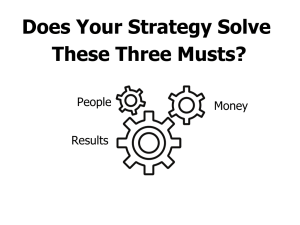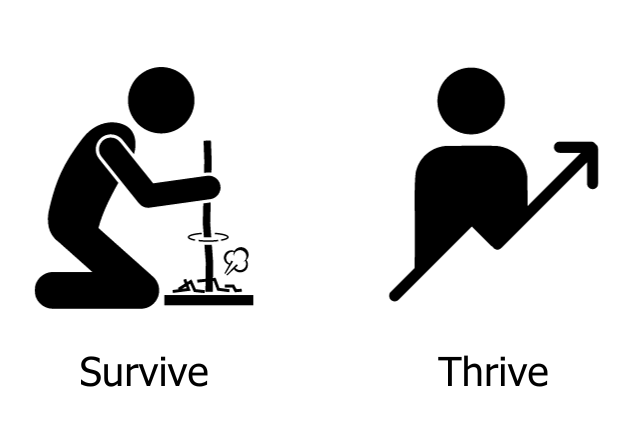
Nonprofit Strategy for Major Gifts: 3 Must-Have Elements
What do people say about your nonprofit when you’re not around?
Do they think that you know where you are going and making inroads?
Or do they think you do “good work?”
Period.
What’s the difference between the two answers? Using an effective strategy.
Why Read This? Too much has been written about nonprofit strategic planning and strategy. Why should you read more? To discover a framework for generating an effective strategy and to grasp the mindset of nonprofit investors who make unsolicited major gifts.

The Effective Nonprofit Strategy for Major Gifts Framework
For nonprofits, winning strategies contain three “musts.” Think of them as interlocking gears. When designed well, they spin together and move nonprofits toward their goals.
Effective strategies outline how the nonprofit will logically create:
I. Lots of results
II. Plenty of people and
III. Financial resources to thrive.
That’s the framework. How about the mindset of nonprofit investors? Your attractiveness to them grows when all three gears operate at full throttle. In the next section, we explore each gear, maximum performance, and the challenges nonprofits face.
A. The Challenge
As you know and will relearn from this post, creating an effective strategy is no small feat. It’s one of the most daunting tasks that boards and staff tackle. Every nonprofit faces steep odds. Many fail even if they post a “Strategic Plan.”
Is it worth the effort? Yes. From the CEO’s viewpoint, using an effective strategy keeps professional lives manageable, productive, and rewarding. When you develop and use an effective strategy, you begin a virtuous cycle that brings more outcomes, people, and resources your way.
Going Deeper
Let’s start with the money aspect or your financial strategy. Why? Because everything else is secondary for when funds are tight.
Must 1. Money
The financial strategy defines how nonprofits fund their work.
At a minimum, an effective financial strategy ensures survival. Strategy implementation leads to covering core expenses and avoiding financial cliffs.
Unfortunately, some nonprofits have inadequate financial strategies. Some shut down—approximately 3 percent each year, according to Candid and the National Center for Charitable Statistics.

What Nonprofit Investors Seek
Few nonprofit investors find survival attractive.
Nonprofit leaders agree! Worrying about surviving is demoralizing. CEOs aspire to make an impact. For them, an effective financial strategy generates profits—money exceeding expenses.
Profits allow nonprofits to:
- Expand capacity, such as sending staff on field trips to discover how similar entities operate,
- Foster innovation, i.e., adding an experimental play to a season,
- Cover funding gaps, such as the parking ticket a donor gets while visiting,
- Sock away reserves and more.
Why This MUST Challenges
With these strategic challenges in mind, let’s turn to people.
The nonprofit landscape is fiercely competitive. Funding streams are limited, specialized, and changeable. Over-reliance on a single source is a common pitfall. Further, boards mean well, but most lack knowledge about the nuances of capturing nonprofit income streams. Finally, reaching for new revenue brings risks—often to current streams.
MUST 2. People
By definition, nonprofits are collective enterprises that build and lead durable communities. As the Skoll Foundation states, “We can’t do it alone. It takes a community to drive enduring impact.”
The people aspect of strategic plans identifies how the nonprofit will create and sustain a right-sized and right-skilled community of support.

Many strategies involve getting likes, followers, or newsletter sign-ups—easy one-and-done “wins.”
In contrast, effective strategies gather new people, keep the old (reducing backdoor losses), and engage individuals. Hence, these individuals spend their time or money on the nonprofit.
What Nonprofit Investors Seek
Unsolicited nonprofit investors seek impact, permanence, or similar goals. So do nonprofit leaders.
Effective strategies show how the nonprofit will:
- Move supporters from investing some resources (a $50 gift or one-off volunteering) to commitments—for instance, annual giving and committee work.
- Engage “the right people” those who add knowledge, connections, resources, or access to them to the table.)
Why This MUST Challenges
Nonprofits need visibility to be heard in the noisy, competitive market. Then, they need persuasive invitations to coax engagement. Along with this undertaking, effective strategy points to how the nonprofit will manage the logistical work of managing more people since more people means more work.
The third gear, results, is the most important, and it won’t move or go at top speed without the others.
MUST 3: Results
Effective strategies are not just about generating money or attracting people. They generate results.
At a minimum, nonprofits create similar solid results yearly. That is the status quo.
Effective strategies target growth and high-quality, sustainable expansion. The upgrade or continuous improvement can be in numbers, tactics, or service quality.

What Nonprofit Investors Seek
For some investors, growth is your ticket.
For other investors, the slow growth or the status quo is inadequate. They seek significant impact—” to bend the arc of the moral universe toward justice,” as Martin Luther King, Jr. stated. Fortunately, when it comes to this impact, one size does not fit everyone.
For some investors, it means:
- Creating a grassroots movement
- Changing the system
- Building out a program nationally or internationally
For others, the impact is more nuanced (and therefore, reachable by locally-focused nonprofits), such as,
- Modeling a solution
- Ambition–for example, making inroads to being the best in your field in your state, region, or country
Why this MUST Challenges
Nonprofits work in the space between for-profits and governments. When solutions are profitable, for-profits engage. If governments embrace the work as an essential public service, they’d provide the service or adequately fund it.
By definition, nonprofits operate in low-profit, low-funding arenas and deliver results where few easy solutions exist. The sector’s work demands ingenious strategies.
With all these demands, is it any wonder that competitive, high-quality nonprofit strategies are rare? And that nonprofit investors seek them? Yet, nonprofits design them every day.
That’s enough theory. Let’s see the framework in action.
B. Effective Example of Nonprofit Strategy at Work
Here are several effective strategies and associated unsolicited windfalls.
Playworks transforms the school recess to nurture children’s social and emotional growth. They contract with schools and train coaches to orchestrate inclusive and affirming play encounters within schools. Gift—Robert Wood Johnson: $4.4 million
Habitat for Humanity raises funds to build houses, enlists volunteers to construct them, and opens resale stores to cover staff overhead. Results? Habitats sell homes to families with affordable mortgage payments. These payments contribute to building more houses. Gifts: numerous
Homeboy Industries guides the formally incarcerated and those involved in gangs in Los Angeles. They offer job training, employment opportunities, and support services and operate social enterprises such as a bakery and a cafe to create job prospects. Gift—Yield Giving: $20 million
Effective strategies create three gears and movements toward visions. They enable nonprofits to thrive despite limited resources and fierce competition.
An effective strategy is your key to showing other people you know where you are going and making inroads. Let’s start with your strengths. Which one of these three strategy gears is your strongest?
The Way Forward Nonprofit Strategic Planning that Creates Effective Strategies
As a nonprofit leader, the responsibility for an effective strategy rests on your shoulders, but you don’t have to face the challenge alone.
Explore our approach to strategic planning. We specialize in demystifying nonprofit income streams and crafting strategies that empower organizations to thrive—ones that maximize your results and potential for unsolicited gifts.
***
You can keep up with Karen. Subscribe to the newsletter, Karen’s CEO Solutions.
Karen Eber Davis is a nonprofit strategic planning consultant who works with visionary leaders committed to taking their organizations to new heights. She offers customized strategies, assessments, and coaching designed to help leaders lead their organizations to achieve their potential. She is the author of 7 Nonprofit Income Streams and Let's Raise Nonprofit Millions Together.
Categories
If you appreciate these Added Value posts, please consider subscribing.
Latest Posts
- How New Nonprofit CEOs Secure Board Buy-In for Strategic Planning
- How Nonprofit Leader Navigate Crisis with Clarity & Confidence
- One Way AI Can Help You Find a Path Where None Exists
- In Crisis? Resist Cutting Your Ability to Make Income
- Nonprofit Strategic Planning Assessment: 10 Questions to Strengthen Your Strategy
